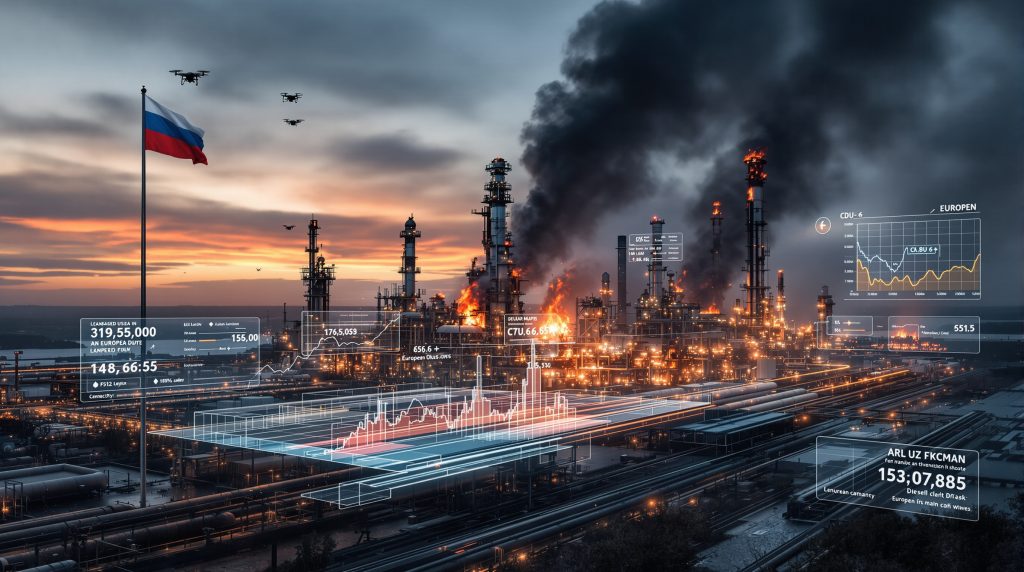How Did the Ukrainian Drone Strike Impact Russia's Kirishi Refinery?
The recent Ukrainian drone attack on Russia's Kirishi oil refinery has forced the shutdown of its largest crude distillation unit (CDU-6), significantly reducing the facility's operational capacity. This strategic strike has created ripple effects across both domestic Russian fuel markets and European supply chains, highlighting the vulnerability of critical energy infrastructure during ongoing geopolitical tensions.
The attack, which occurred on October 4, 2025, targeted one of Russia's most modern and productive refineries, causing immediate disruption to approximately 160,000 barrels per day of processing capacity. With repair timelines estimated at around one month, this incident represents one of the most consequential energy infrastructure disruptions in recent months as oil prices ease amid shifting market dynamics.
What Makes the Kirishi Refinery Strategically Important?
Critical Infrastructure Profile
The Kirishi refinery, operated by Surgutneftegaz, stands as one of Russia's premier petroleum processing facilities. Located in Leningrad Oblast, approximately 115 kilometers southeast of St. Petersburg, this facility plays a crucial role in Russia's energy infrastructure for several reasons:
- Contributes approximately 6.6% of Russia's total refining capacity
- Specializes in producing high-quality diesel, jet fuel, and other petroleum products
- Serves as a key supplier for northwestern Russia and export markets
- Features some of Russia's most modern refining technology
The facility's strategic location provides it with excellent logistics connections to both domestic markets and European export channels, making any disruption particularly significant for regional fuel supplies.
CDU-6: The Heart of Operations
The damaged crude distillation unit, known as CDU-6, represents the primary processing center within the Kirishi complex:
| CDU-6 Specifications | Details |
|---|---|
| Daily processing capacity | 160,000 barrels |
| Percentage of total refinery capacity | ~40% |
| Primary products | Naphtha, diesel, fuel oil |
| Technology type | Advanced atmospheric distillation |
This unit's importance cannot be overstated—it functions as the initial processing stage for a substantial portion of the refinery's crude oil intake, separating raw petroleum into various component streams that feed downstream units.
What Are the Immediate Consequences of the Strike?
Operational Impact Assessment
Following the strike, Surgutneftegaz implemented emergency protocols to maintain partial operations while assessing damage to the CDU-6 unit. According to industry analysts, the refinery is expected to:
- Operate at approximately 70% of normal capacity during repairs
- Redistribute crude flows to remaining operational units
- Prioritize production of critical fuels like diesel and gasoline
- Potentially delay scheduled maintenance on other units
The company has mobilized repair teams and engineering specialists to restore the damaged unit, though complete repairs are expected to take approximately 30 days under optimal conditions.
Market Response and Price Effects
The market reaction to the Kirishi disruption has been pronounced, particularly in European fuel markets:
- Diesel futures experienced immediate upward pressure, with Northwest European prices rising 2-3%
- Refining margins for diesel production increased across European facilities
- Traders reported accelerated booking of alternative supply sources
- Russian domestic fuel prices saw localized increases, particularly in northwestern regions
These price movements reflect the market's concern about potential supply shortages, especially as Europe enters a period of seasonally higher diesel demand with the approach of colder weather.
How Does This Attack Fit Into the Broader Conflict Pattern?
Escalating Infrastructure Targeting
The Kirishi strike represents the continuation of a strategic campaign targeting Russian energy infrastructure. This approach has evolved significantly over the course of the conflict:
- Initial Phase (2022-2023): Limited strikes focused primarily on military fuel depots
- Expansion Phase (2024): Targeting of border-area refineries and storage facilities
- Current Phase (2025): Systematic attacks on major refineries deeper within Russian territory
The Kirishi facility itself has been struck multiple times this year, with previous attacks in March and September causing varying degrees of damage. This latest strike, however, appears to be the most consequential in terms of operational impact and global trade impact.
Dual-Strike Strategy
The attack on Kirishi coincided with another Ukrainian drone strike targeting the Feodosia oil terminal in Russian-occupied Crimea. This coordinated approach suggests a deliberate strategy to simultaneously disrupt both:
- Refining capacity (Kirishi)
- Distribution infrastructure (Feodosia)
By targeting these complementary components of the fuel supply chain, the strikes create compounding effects that are more difficult to mitigate through alternative sourcing or logistics arrangements.
What Are the Broader Implications for European Fuel Markets?
Supply Chain Vulnerabilities Exposed
The key Russian refinery unit halted after strike highlights several structural vulnerabilities in European fuel supply chains:
- Continued Dependency: Despite sanctions and diversification efforts, European markets remain partially dependent on Russian-origin refined products through indirect channels
- Limited Buffer Capacity: European refineries are operating near maximum capacity, limiting their ability to compensate for supply disruptions
- Seasonal Timing: The disruption comes as Europe enters a period of higher seasonal demand for heating fuels
- Logistical Constraints: Alternative supply sources often face transportation bottlenecks and higher delivery costs
These factors combine to create a particularly challenging environment for European fuel markets already dealing with tight supply-demand balances, further complicated by recent OPEC meeting impact on global oil production.
Diesel Market Particularly Affected
The European diesel market appears most vulnerable to disruptions at Kirishi for several reasons:
- Russia has historically been a major diesel supplier to European markets
- European refineries typically produce less diesel relative to gasoline compared to Russian facilities
- Alternative diesel suppliers (Middle East, Asia) face longer delivery times and higher shipping costs
- Industrial and transportation sectors have fewer immediate substitution options for diesel
Industry analysts suggest that prolonged disruption at Kirishi could potentially widen the diesel premium over crude oil, incentivizing increased production at other facilities but also raising costs for end users.
How Is Russia Responding to the Refinery Disruption?
Operational Adjustments
Surgutneftegaz has implemented several measures to mitigate the impact of the CDU-6 shutdown:
- Increasing throughput at remaining operational units where technically feasible
- Adjusting product slate to prioritize critical fuels
- Mobilizing specialized repair teams from other facilities
- Potentially sourcing replacement components from domestic suppliers or friendly nations
These measures aim to minimize the duration and severity of the production shortfall, though full restoration of capacity will require substantial repairs to the damaged unit.
Strategic Countermeasures
Beyond the immediate technical response, Russian authorities have indicated several broader strategic initiatives:
- Enhanced air defense deployments around critical energy infrastructure
- Accelerated development of decentralized refining capacity to reduce vulnerability
- Creation of larger strategic fuel reserves at dispersed locations
- Exploration of alternative export routes less vulnerable to interdiction
These longer-term measures reflect growing recognition of energy infrastructure as a strategic vulnerability requiring systematic protection and redundancy.
What Does This Mean for Global Energy Security?
Cascading Supply Chain Effects
The Kirishi disruption illustrates how localized infrastructure damage can create far-reaching supply chain impacts:
- Initial production loss at the refinery
- Reduced product flows to immediate markets
- Price signals triggering inventory drawdowns
- Reallocation of alternative supplies from other regions
- Potential shortages in tertiary markets as supplies are redirected
This cascade of effects demonstrates the interconnected nature of global energy markets and the potential for regional disruptions to create global ripple effects, particularly affecting countries facing energy exports challenges.
Reassessment of Infrastructure Vulnerability
The successful strike on a facility of Kirishi's importance is prompting reassessment of critical infrastructure vulnerability across the energy sector:
- Enhanced physical security measures at comparable facilities worldwide
- Accelerated investment in redundant systems and rapid repair capabilities
- Greater emphasis on distributed production capacity to reduce concentration risk
- Increased stockpiling of critical components for rapid replacement
These adaptations reflect growing awareness that energy infrastructure represents a high-value target in modern conflicts, requiring correspondingly sophisticated protection measures and heightened energy security transition strategies.
How Long Will Repairs Take and What Are the Recovery Scenarios?
Repair Timeline Assessment
Based on industry precedents and the reported nature of the damage, several recovery scenarios are possible:
| Scenario | Timeline | Conditions |
|---|---|---|
| Best Case | 3-4 weeks | Minor structural damage, available replacement parts |
| Base Case | 4-6 weeks | Moderate damage, some components requiring fabrication |
| Worst Case | 2-3 months | Severe structural damage, specialized components needed |
The actual timeline will depend on several factors including the precise nature of the damage, availability of replacement components, and access to specialized repair expertise.
Production Recovery Trajectory
Even after physical repairs are completed, the return to full production is likely to follow a gradual trajectory:
- Initial restart: Reduced throughput with extensive monitoring (60-70% capacity)
- Optimization phase: Gradual increase as systems are tuned (70-90% capacity)
- Full recovery: Return to normal operational parameters (100% capacity)
This phased approach reflects standard industry practice for returning major processing units to service after significant repairs, prioritizing safety and equipment integrity over immediate production recovery.
What Are the Long-Term Implications of Targeting Energy Infrastructure?
Evolving Conflict Dynamics
The targeting of civilian energy infrastructure represents a significant evolution in modern conflict patterns:
- Blurs traditional distinctions between military and civilian targets
- Creates effects that impact civilian populations beyond conflict zones
- Introduces complex ethical and legal questions regarding proportionality
- Potentially establishes precedents for future conflicts
These developments suggest a concerning trend toward broader targeting parameters that could have far-reaching implications for international humanitarian law and conflict norms.
Energy Security Reassessment
The vulnerability demonstrated by the key Russian refinery unit halted after strike is accelerating broader reassessment of energy security concepts:
- Greater emphasis on infrastructure hardening and physical protection
- Increased investment in distributed and redundant energy systems
- Accelerated development of alternative supply chains and energy sources
- Enhanced international cooperation on critical infrastructure protection
These adaptations reflect growing recognition that traditional energy security frameworks focused primarily on supply adequacy must evolve to address physical infrastructure vulnerability as a core component.
FAQ: Key Questions About the Kirishi Refinery Attack
How does this attack compare to previous strikes on Russian refineries?
This attack appears more consequential than previous strikes due to its successful targeting of the facility's largest and most productive unit. While earlier attacks on Kirishi and other refineries caused temporary disruptions, the CDU-6 damage represents a more significant operational impact affecting a larger percentage of the facility's total capacity.
Could European countries face fuel shortages as a result?
While complete shortages are unlikely, certain markets may experience tightened supply conditions, particularly for diesel fuel. The most vulnerable regions would be those with limited storage capacity, fewer alternative supply options, or higher dependence on imports. Price increases are more likely than outright shortages as market mechanisms redirect available supplies.
How will this impact global oil prices?
The direct impact on crude oil prices is likely to be limited, as the disruption affects refining capacity rather than oil production. However, refined product prices—particularly diesel—may see more significant effects. The price spread between crude oil and finished products (the "crack spread") may widen, reflecting the refining bottleneck created by the capacity loss.
What defensive measures might protect refineries from similar attacks?
Modern refinery defense systems typically include multi-layered approaches combining:
- Advanced radar and detection systems
- Electronic countermeasures to disrupt drone guidance
- Physical interception capabilities (anti-drone weapons)
- Hardened structures for critical processing units
- Redundant control systems and rapid shutdown protocols
The effectiveness of these measures depends on their integration, maintenance, and the evolving capabilities of attacking systems.
Further Exploration:
Readers interested in learning more about the geopolitical dynamics of energy infrastructure targeting can also explore related educational content from energy analysis publications, which offer regular updates and analysis on global energy security issues and market impacts of supply disruptions.
Disclaimer: This article contains analysis of a developing situation. Market conditions and repair timelines are subject to change as more information becomes available. Readers should consult multiple sources when making business or investment decisions related to the events described.
Want to Be First to Profit From Major ASX Mining Discoveries?
Discovery Alert's proprietary Discovery IQ model instantly notifies investors about significant mineral discoveries on the ASX, transforming complex geological data into actionable investment opportunities before the broader market reacts. Explore how historic discoveries have generated exceptional returns by visiting the dedicated discoveries page and position yourself for potential market-beating gains.




